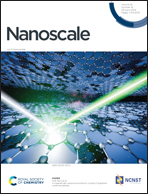Self-propelling bacteria-based magnetic nanoparticles (BacMags) for targeted magnetic hyperthermia therapy against hypoxic tumors†
Abstract
Magnetic hyperthermia-based cancer therapy (MHCT) holds great promise as a non-invasive approach utilizing heat generated by an alternating magnetic field for effective cancer treatment. For an efficacious therapeutic response, it is crucial to deliver therapeutic agents selectively at the depth of tumors. In this study, we present a new strategy using the naturally occurring tumor-colonizing bacteria Escherichia coli (E. coli) as a carrier to deliver magnetic nanoparticles to hypoxic tumor cores for effective MHCT. Self-propelling delivery agents, “nano-bacteriomagnets” (BacMags), were developed by incorporating anisotropic magnetic nanocubes into E. coli which demonstrated significantly improved hyperthermic performance, leading to an impressive 85% cell death in pancreatic cancer. The in vivo anti-cancer response was validated in a syngeneic xenograft model with a 50% tumor inhibition rate within 20 days and a complete tumor regression within 30 days. This proof-of-concept study demonstrates the potential of utilizing anaerobic bacteria for the delivery of magnetic nanocarriers as a smart therapeutic approach for enhanced MHCT.

- This article is part of the themed collection: Nanoscale 2024 Emerging Investigators


 Please wait while we load your content...
Please wait while we load your content...